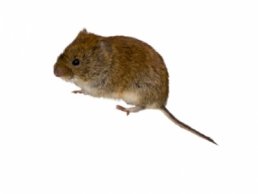Vole
Commonly called meadow mice, voles thrive in both grasslands and mountainous areas. They can be found throughout the United States and feed on a variety of plants. Their feeding habits damage growing trees, lawns, and gardens.
Biology & Behavior
Voles, also referred to as meadow mice, are small mouse to rat sized rodents. They are pudgy, with blunt faces, small eyes, short ears, short legs, and a short tail. Eight species of voles are widely distributed throughout the various ecosystems of Utah.Voles are adapted to digging and build many tunnels and surface runways with numerous burrow entrances. They are active throughout the day and do not hibernate in winter. Vole activity is closely tied to the grasses that are their primary food.Voles can be reproductively active throughout the year. The average number of litters varies from 3 to 12, with the number of young varying from 3 to 6 per litter. Due to their active nature during winter, they are a valuable food source for owls, foxes, coyotes, and other predators.
Noises
What Does a Vole Sound Like?
Voles are social rodents, so noises are a primary means of communication. When frightened or in danger, the pests emit chirps similar to those made by mice. However, the high frequency of many vole sounds is beyond the human hearing range. Voles also make rustling noises as they run through their burrows.
Tracks

When the snow melts from your yard, you may notice little pathways in your grass. These pathways are caused by voles (not moles), which are also commonly referred to as meadow mice. Voles tunnel under the snow and eat the grass clippings during the winter months and also use the grass to build nests.
Scat
Vole droppings look very similar to mouse scat, but in a greenish or grayish color. They can typically be seen scattered along their trails and in their grassy nests, but droppings will also been seen anywhere that the voles go.
Damage
Vole cause many types of damage. They feed on and girdle nursery stock, fruit trees, and ornamental plantings. They damage lawns by building runways under the snow. They also damage root crops, bulbs, and tubers. Most damage by voles occurs under the snow during the winter.
Pictures
Commonly ASKED QUESTIONS?
What do you do with trapped animals?
That answer depends on the state in which you live. Each state has their own laws that dictate what we must do when it comes to controlling wildlife on your property. In some states, we can trap, transfer and release the animals. In some states we can trap the animals, but we can only release them back onto your own property. If you don’t want the animal released on your property, it must be humanely euthanized. Sometimes we don’t even need to trap the animal and a simple exclusion device (one-way door) can be installed to allow the animal to exit your home and be locked out.
How much does it cost to remove an animal?
There are a number of factors that determine pricing; location of the animal (i.e. – chimney, attic, crawl, wall void, living area), condition of the animal (i.e. – sick, aggressive, dead), location and condition of the property and time of year (i.e. – weather condition, offspring present?). Generally speaking, pricing will vary by location and species for just the animal removal and that pricing usually does not include the entry repair.
I think I have birds in my chimney, can you get them out?
The answer to that question is most likely “Yes”, but are you sure what you’re hearing is birds? Raccoons easily invade chimneys and they have their litters on the smoke shelf of fireplaces. The sounds baby raccoons make are often mistaken for birds in chimneys and removal can be difficult. The only birds that nest in chimneys are chimney swifts and they’re federally protected, so removal can’t be performed, but exclusion can be – once they depart. If you have a pre-fabricated chimney and birds fall between the cooling tubes, removal is nearly impossible.
How soon can you get here?
Office hours vary from franchise to franchise, but generally speaking, office hours are 8am – 6pm M-F and 9am – 3pm on Saturdays.
Clients Testimonials
OUR EXPERTS WILL SOLVE THEM IN NO TIME.
Have Any Pest Problems?
Navigations
Contact Information

At Critter Removers we're committed to providing you with the highest level of services and solutions to best fit your pest or critter control needs.

